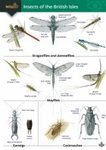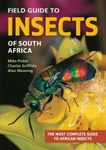Textbook
By: RF Chapman(Author), Stephen J Simpson(Editor), Angela E Douglas(Editor)
929 pages, 597 b/w photos and illustrations, 26 tables
![The Insects The Insects]()
Click to have a closer look
About this book
Contents
Customer reviews
Related titles
About this book
The Insects has been the standard textbook in the field since the first edition published over forty years ago. Building on the strengths of Chapman's original text, this long-awaited 5th edition has been revised and expanded by a team of eminent insect physiologists, bringing it fully up-to-date for the molecular era. The chapters retain the successful structure of the earlier editions, focusing on particular functional systems rather than taxonomic groups and making it easy for students to delve into topics without extensive knowledge of taxonomy. The focus is on form and function, bringing together basic anatomy and physiology and examining how these relate to behaviour. This, combined with nearly 600 clear illustrations, provides a comprehensive understanding of how insects work. Now also featuring a richly illustrated prologue by George McGavin, this is an essential text for students, researchers and applied entomologists alike.
Contents
Preface
Acknowledgments
Prologue George C. McGavin
Part I. The Head, Ingestion, Utilization and Distribution of Food
1. Head Stephen J. Simpson
2. Mouthparts and feeding Stephen J. Simpson
3. Alimentary canal, digestion and absorption Angela E. Douglas
4. Nutrition Angela E. Douglas and Stephen J. Simpson
5. Circulatory system, blood and the immune system Angela E. Douglas and Michael T. Siva-Jothy
6. Fat body Deborah K. Hoshizaki
Part II. The Thorax and Locomotion
7. Thorax Graham K. Taylor
8. Legs and locomotion Graham K. Taylor
9. Wings and flight Graham K. Taylor
10. Muscles John C. Sparrow
Part III. The Abdomen, Reproduction and Development
11. Abdomen Leigh W. Simmons
12. Reproductive system: male Leigh W. Simmons
13. Reproductive system: female Leigh W. Simmons
14. The egg and embryology Michael R. Strand
15. Postembryonic development Stuart Reynolds
Part IV. The Integument, Gas Exchange and Homeostasis
16. Integument Hans Merzendorfer
17. Gaseous exchange Jon F. Harrison and Lutz Thilo Wasserthal
18. Excretion and salt and water regulation Julian Dow
19. Thermal relations John S. Terblanche
Part V. Communication
Section 1. Physiological Co-ordination within the Insect
20. Nervous system Stephen Rogers
21. Endocrine system Stuart Reynolds
Section 2. Perception of the Environment
22. Vision Michael F. Land and Lars Chittka
23. Mechanoreception Tom Matheson
24. Chemoreception Bronwen Cribb and David Merritt
Section 3. Communication with other Organisms
25. Visual signals: colour and light production Peter Vukusic and Lars Chittka
26. Mechanical communication: producing sound and substrate vibrations Ralf Heinrich
27. Chemical communication: pheromones and chemicals with interspecific significance Jeremy McNeil and Jocelyn G. Millar
Taxonomic index
Subject index
Customer Reviews
Textbook
By: RF Chapman(Author), Stephen J Simpson(Editor), Angela E Douglas(Editor)
929 pages, 597 b/w photos and illustrations, 26 tables
Reviews of the fifth edition:
"If you want to understand how the natural world works, you need to know about insects – the most successful and important multi-cellular organisms on our planet. The key to that understanding is now in your hands. Extensively revised and updated, this is a quite extraordinary book and effectively summarises everything you need to know about insects. Authoritative yet accessible, The Insects: Structure and Function is the clearest and most comprehensive guide ever written on the workings of insects."
– George McGavin, University Museum of Natural History and Oxford University
"This new edition of The Insects: Structure and Function fascinates the reader with details on the morphology, processes and mechanisms which allow insects to burgeon on Earth. The tradition of excellence established by Chapman has been perpetuated. Thoroughly modernized and comprehensive, the revision captures the excitement of recent major advances in understanding."
– Peter W. Price, Regents' Professor Emeritus, Northern Arizona University
Reviews of previous editions:
"[...] a high standard of comprehensiveness and accuracy [...] will surely prove to be a really useful book."
– Nature
"The book is superbly illustrated with line drawings, graphs, and occasional halftone photographs [...] The text itself is written very clearly and one can recommend this to either undergraduate or graduate students without any hesitation whatsoever. The abundant literature citations and excellent index add to the value of the textual discussions, making this book an invaluable resource for any biologist working with insects and aspects of their chemical ecology and physiology."
– Thomas C. Emmel, Journal of Chemical Ecology
"This book should be on the shelf of every entomologist and student of insects. It is a splendid and much needed revision that brings insect structure and function up to date in the most accessible fashion."
– Quarterly Review of Biology





































